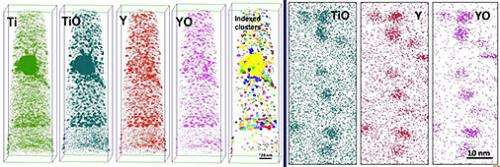Nanoclusters in steel add strength, stability under irradiated conditions

Safely containing and retarding the mobility of reactor fuels are longstanding U.S. Department of Energy and Department of Defense concerns, making the radiation stability of the materials used for structural components and fuel cladding critically important. In this study, scientists used various analysis tools, including EMSL's atom probe tomography (APT), focused ion beam, and accelerator capabilities, to examine complex oxide nanoclusters within oxide dispersion strengthened, or ODS, steels to determine their potential resistance and stability under a range of irradiation conditions. The complex nanoclusters in ODS steels increase the metal's high-temperature strength, making ODS steel viable for use in nuclear structure or cladding applications.
In this work, two ODS steels—14YWT and 9CrODS—underwent proton, heavy-ion, and neutron irradiations under controlled temperatures. EMSL's sensitive atom probe, which works especially well with metal materials, can separate a sample's elements and reconstruct them in a three-dimensional visual. This allowed the scientists to calculate and quantify the nanoclusters, showing that irradiation temperature affected cluster size distributions. However, the number of clusters remained constant across the heavy-ion-irradiated conditions (where clusters were detected). This indicates that although collision cascades displace atoms during annealing, no new clusters are nucleating. Thus, if the temperature is high enough, ejected particles diffuse back to the parent cluster, resulting in a stable environment.
In their varied analyses, the scientists determined diffusion also affected both the instability of the nanoclusters at low temperatures, with little or no particle diffusion, and stability at high temperatures, where diffusion allowed ejected atoms to re-form nanoclusters. Moreover, it showed how ODS steels can offer long-term radiation resistance.
More information: Certain, A. et al. 2013. Radiation stability of nanoclusters in nano-structured oxide dispersion strengthened (ODS) steels. Journal of Nuclear Materials 434(1-3):311-321. DOI: 10.1016/j.jnucmat.2012.11.021
Provided by Environmental Molecular Sciences Laboratory


















